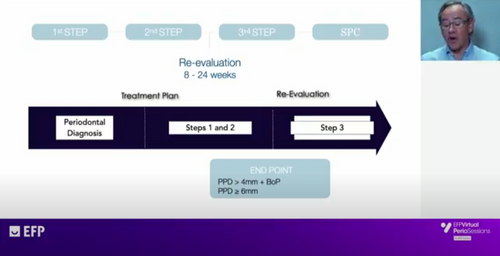![]()
11 December 2020
EFP Perio Sessions: Mariano Sanz outlined EFP clinical practice guideline
Categories:Clinical Practice, Communication, New Classification

The first EFP Perio Sessions webinar of the 2020-21 season featured a presentation by Mariano Sanz on the federation’s new clinical practice guideline on the treatment of periodontitis.
Prof Sanz explained that while evidence-based guidelines are common in medicine, the one drawn up by the EFP at Perio Workshop 2019 and published in July this year is the first in the field of dentistry.
While there are evidence-based clinical practice guidelines for many conditions including diabetes, hypertension, depression, and low back pain, “it was a pity that in dentistry these did not exist,” he said during the webinar on November 19. “The EFP thought it was an appropriate time to develop a clinical practice guideline following all the requirements that the Institute of Medicine of the United States and the European medical agencies require for high-level clinical practice guidelines.”
The guideline, Treatment of stage I-III periodontitis – The EFP S3-level clinical practice guideline, is of S3 level, the highest level, which means that it required systematic reviews, an international expert group, and external stakeholders to draw it up, following a transparent and rigorous process.
“These clinical guidelines are intended to communicate in a very transparent way what is the evidence behind all the treatment interventions that we do in a particular medical speciality, and in this case dealing with the treatment of periodontitis,” said Prof Sanz, who chaired Perio Workshop 2019.
While noting the rigour of the systematic-review process, he said that it was not possible to perform meta-analyses in all cases. For instance, with the review of studies of the resective approach, “the data was so heterogeneous that it was impossible to aggregate in a meta-analysis fashion.”
With the final meta-analysis in the review of studies on psychological interventions in behavioural change to improve oral hygiene, “the aggregate data does not show a significant difference between the experimental and the control. These particular interventions do not have the scientific evidence of efficacy that we are looking for.”
Prof Sanz, professor of periodontology at the Complutense University of Madrid, emphasised that the guideline’s recommendations are based not only on the scientific evidence: “A recommendation should also be based on the environment where this treatment is going to be provided, it has to be involved with the patient, and other social, economic, and practical conditions.”
Step by step
After explaining the workshop’s system of recommendations, how the strength of consensus was expressed, and how conflicts of interest were handled, Prof Sanz took participants in the webinar through the guideline’s step-by-step approach to periodontal treatment, using a particular patient case to illustrate the four steps of therapy set out in the guideline:
- Step 1: Behavioural change, oral hygiene, plaque control and risk-factor control.
- Step 2: Basic subgingival instrumentation, and possible use of adjunctive therapies.
- Step 3: Periodontal surgery.
- Step 4: Supportive periodontal care.
Describing Step 1, he said that “one of our first objectives is to guide behaviour change by motivating the patient to undertake successful removal of supragingival biofilm and risk-factor control” and that this “should be implemented in all patients, irrespective of stage, and re-evaluated frequently through all steps of therapy.”
He stressed the importance of re-evaluation after Step 2 to see if the treatment has been successful – defined in the guideline as bleeding on probing in fewer than 10% of sites, no deep probing depths (6mm or deeper), and no sites of more than 4mm with bleeding on probing. In some cases, instrumentation should be repeated before deciding to proceed to Step 3, periodontal surgery.
In conclusion, Prof Sanz said: “We strongly believe that this clinical practice guideline will help dentists from all over the world to apply a rational treatment to all their patients.”
There were some technical problems with the live webinar so the EFP made the recording available to all participants and then held the question-and-answer session with Mariano Sanz on November 23. Questions raised covered the importance of staging and grading, the adoption of the new classification, the approach to re-evaluation, the use of antibiotics, and whether it may one day be possible to develop a vaccine against periodontitis (see Mariano Sanz answers questions on EFP Guideline).




